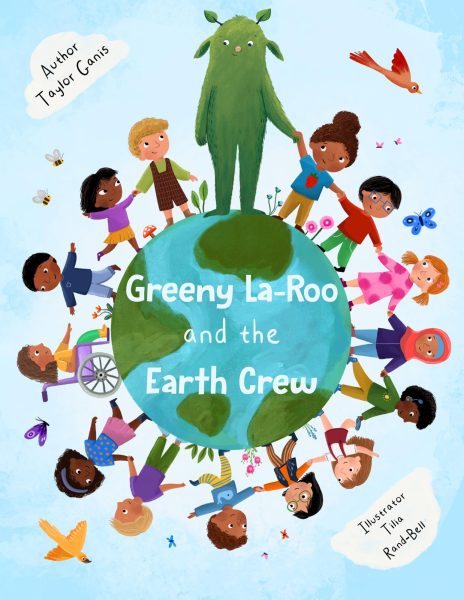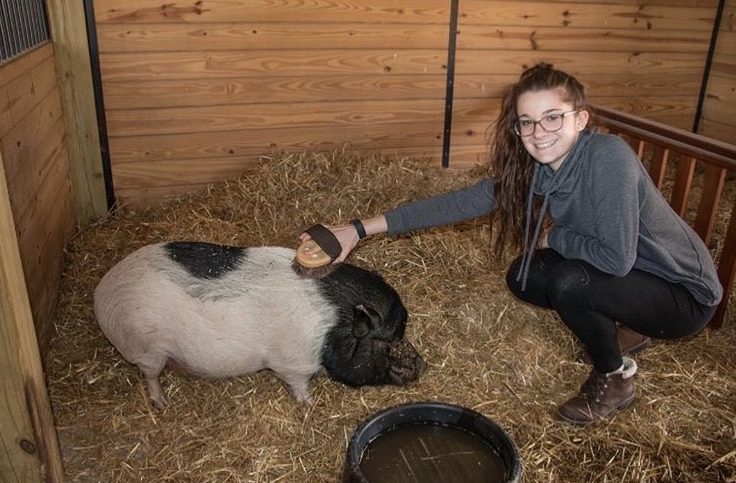Pace University’s Environmental degree program has been recognized for the numerous accomplishments made by students within the department in internships as well as after graduation. Environmental Science alumna Taylor Ganis is a success story for the program.
Pace Alumnus Taylor Ganis has had a lot of experience in the field since graduating with her undergraduate degree in 2021, and just last year with her master’s in environmental science and policy. Now, Taylor works as a consultant and contractor for the government agency NOAA (The National Oceanic and Atmospheric Association). Most notably, Ganis recently completed her first children’s book, titled “Greeny La-Roo and the Earth Crew”.
As an undergraduate student before the COVID-19 pandemic, Ganis was involved in many of the opportunities that the environmental department had to offer. At the time, the farm was not just an empty barn and vacant cages. For Pace, the farm was a place for students to see rescued farm animals, not for programs such as agriculture like other colleges that have farms.

During the summer of 2020, Ganis received an email from the university stating that the farm animals were to be removed. “It was a really hard time, a lot of students used the farm as an outlook like to go out and just see the animals.”, Ganis explained regarding the shutdown of the farm. “We had something very unique on this campus.”
Ganis and other animal caretakers spearheaded a petition that got 2,000 signatures to keep the farm animals. She said, “Losing that I think was really hard for many of us and we had a group of the animal caretakers […] we got together and we just tried to get the administration to keep it but unfortunately they did not and that was a very hard and controversial thing that happened.”
“I am a big and firm believer that every institution can do more, especially colleges. I think they can always do more and do better jobs at that. In the environmental department, they do a great job with doing that, but we’re still a small group of people on campus. […] It needs to grow into other parts of the university.”
Ganis gave her advice to current Pace students on how they can get involved. “You don’t need to be an environmental major to care about the environment, to know what you’re talking about, to advocate for environmental justice or whatever niche of the environmental movement you want to. It’s a very intersectional movement.”
Having people in the movement who aren’t in the environmental space can be beneficial to the cause. “We need people to write about this, it can’t just be me writing policies and no one talking about them.”
“You need someone to go to the news and write it in journals. You need criminal justice people to be advocating for people who go to jail for being an activist. There are so many things in the movement; economics you need people talking about carbon taxes and all these things so there’s always something for you in the movement.” Ganis said.
Right before diving into her master’s degree, Ganis started a podcast and online platform called “The Hopeful Environmentalist” which she describes as a gleam of hope in the climate space. “…because that is far between, not a lot of people are discussing hope in the climate space,” She said.
“That’s incorporated in my book as well. Okay, these things are hard and the climate crisis is scary but not all hope is lost. I kind of try to do that in my podcast as well bringing on guest speakers talking about different environmental topics. Again, it’s not just blind hope where it’s like here’s hope and we don’t have to do any action. No, it’s here’s the bad things that are happening, but here’s how we can fix them.”
While pursuing her master’s degree at Pace, Ganis took on four internships. ”I interned at the Wolf Conservation Center, The Rockefeller State Park Preserve, the Carrey Institute,” she continued, “And this past summer, The White House Council on Environmental Quality.”
She valued the support she got from Environmental Science professors at Pace. Whether it was through providing resources and funding or finding unique opportunities outside of the classroom, they were there to make it happen.
While working as a Naturalist, or Environmental Educator, the inspiration for her children’s book came to light. “I was doing public programming and I was also doing a summer camp working with children,” She said. “I kind of saw a need for a book that both educates and inspires and entertains as well.” With her book, Ganis hopes to educate young children about the climate crisis and give them tangible solutions they can implement into their lives.
The choice to appeal her book to children was clear. “I think that a lot of children’s media isn’t even about the climate crisis or talking about climate change…”
For my book, I tried to incorporate a bunch of different things and perspectives and small, small actions so that children can take action. Trying to make small change in ways that are actionable and that they can actually do it.”
Ganis started a Kickstarter last fall for her illustrations, and successfully funded over $4,000. Working with illustrator Tilia Rand-Bell, she hopes to release the children’s book in December 2024 or early 2025.

